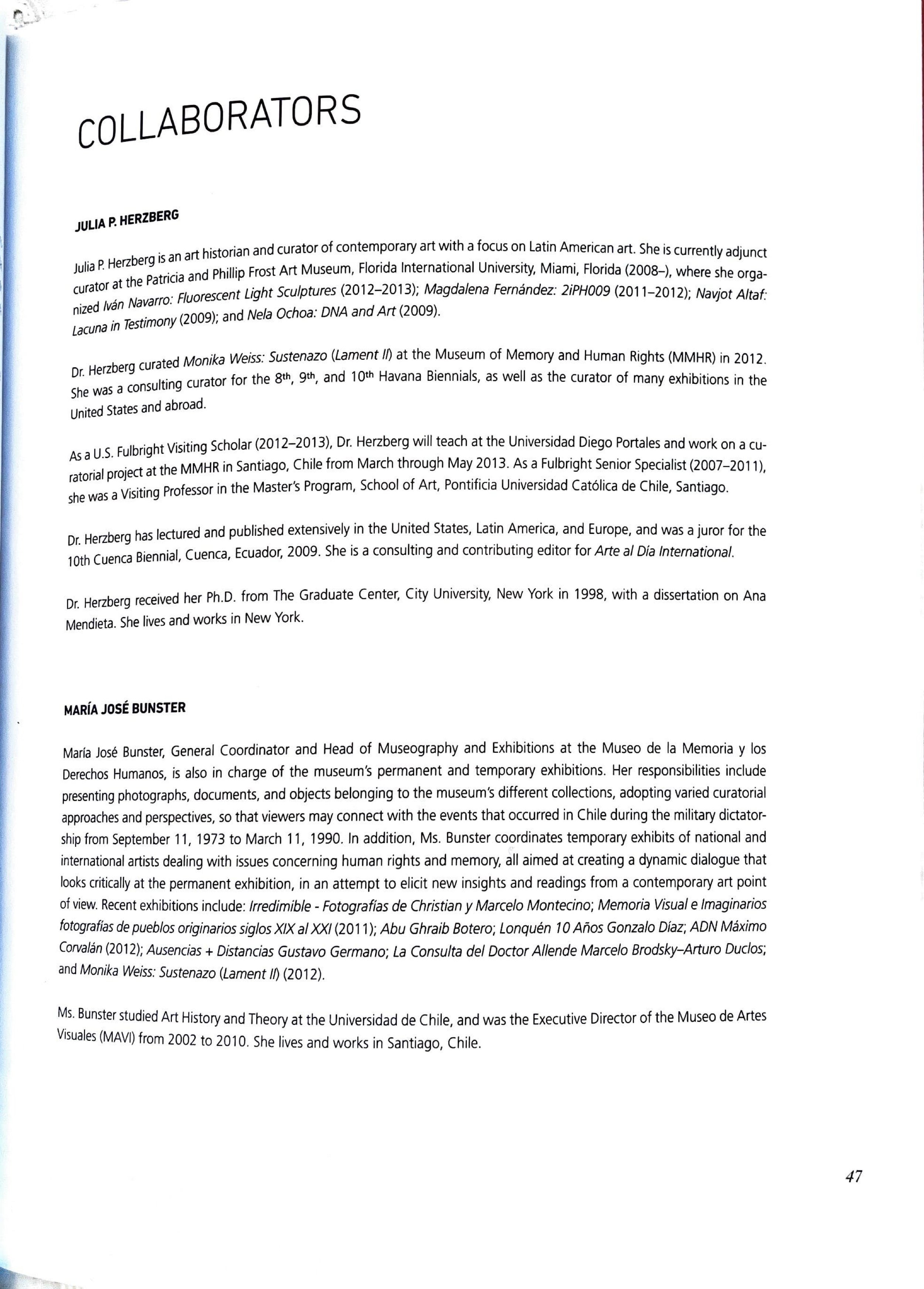Kaarina Kaikkonen: Garments as Memory
The Herzberg essay “Garments as Memory,” is here reprinted as it appeared in Kaarina Kaikkonen Two Projects—Traces and Dialogues/Dos Proyectos—Huellas y Diálogos. Santiago, Chile: Museo de la Memoria y Derechos Humanos, 2013 (Editor Julia P. Herzberg). ISBN 978-956-9144-07-3.
Artist Website: https://kaarinakaikkonen.fi
Kaarina Kaikkonen: Two Projects – Traces and Dialogues
(This is the introductory text for the two exhibitions in Santiago, Chile in 2013.)
The Museum of Memory and Human Rights (MMHR) and the National Museum of Fine Arts (NMFA) have collaborated to bring the renowned Finnish artist Kaarina Kaikkonen to Chile. Two monumental installations Tracesand Dialogues feature thousands of garments in very different compositions in each museum. Traces includes more than eight hundred and fifty men’s jackets connected to each other and placed on the Chacabuco Staircase, one of the two large outdoor staircases leading to the museum’s grand esplanade. Dialogues features about two thousand shirts and blouses that cascade down some twelve meters from the edges of the upper walls under the cupola of the NMFA to the floor of the Central Hall.
In each venue, the compositions are dramatic, the proportions grand, and the artist’s sentiments deeply felt as she addresses such existential questions as forgetting and remembering; strength and frailty; power and impotence; authority and subservience; collective activity and individual motion; departures and arrivals; death and life.
Garments, the artist’s preferred medium, interact with and redefine the architectural spaces into which they are inserted. Chosen for their materiality, color, texture, size, and style, the garments become surrogates for the human body and spirit. Garments embody presence as well as absence, as they are interpreted by each spectator’s personal experiences.
The eight hundred and fifty empty jackets on the steps of the Museum of Memory and Human Rights are quiet, but not silent, each with its own story to tell. For those familiar with the events of the military dictatorship, empty jackets may signal loss, oblivion, anonymity, or perseverance, resistance, and survival, or any combination of these. In all instances, empty jackets stand as metonymic reminders of a landscape held dear—one, hopefully of peace and conciliation—amazing grace.
Julia P. Herzberg, Ph.D., Curator
Kaarina Kaikkonen Two Projects: Traces and Dialogues
(This is the specific text for the exhibition “Traces” at the National Museum of Fine Arts in Santiago, Chile in 2013)
The National Museum of Fine Arts (NMFA) and the Museum of Memory and Human Rights (MMHR) have collaborated to bring the work of the renowned Finnish artist Kaarina Kaikkonen to Chile. Two monumental installations, Dialogues and Traces, incorporate thousands of garments in very different compositions in each museum. Dialogues features about two thousand shirts and blouses that cascade down some twelve meters from the edges of the high walls under the cupola of the NMFA to the floor of the Central Hall. Traces features more than eight hundred and fifty men’s jackets. These garments are connected by thin ropes and placed on one of the two large outdoor staircases (the Chacabuco Staircase) leading to the grand esplanade of the MMHR.
Garments, the artist’s preferred medium, interact with and redefine the architectural space of the Central Hall in the imposing 19th-century Beaux-Arts style building. Meticulously selected for their materiality, color, texture, size, and style, the garments become surrogates for the human body and spirit. Garments embody presence as well as absence, as they are interpreted by each spectator’s personal experiences. The shirts and blouses are joined together physically and metaphorically. Their delicacy, fragility, and temporality counterpoint the adjacent academic-style marble sculptures permanently placed around the hall’s perimeter.
Garments—male and female—face each other in multiple rows spanning the width of the hall. Illuminated by the light of the cupola, they appear engaged in a dialogue of subtle exchange. Joined together in a dramatically theatrical communion, their presence evokes multiple readings of people from all walks of life whose achievements, aspirations, hopes, illusions, joys, cares, and loves were probably similar to ours.
Julia P. Herzberg, Curator




















